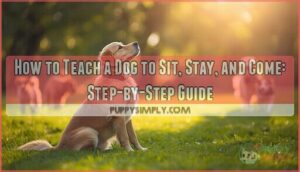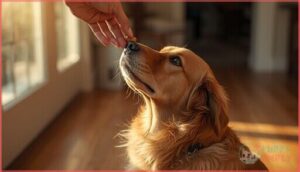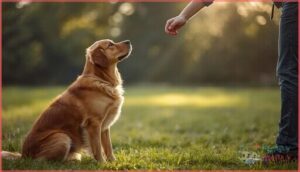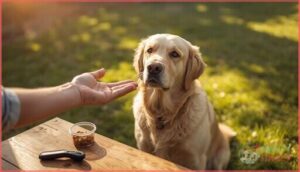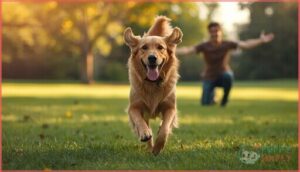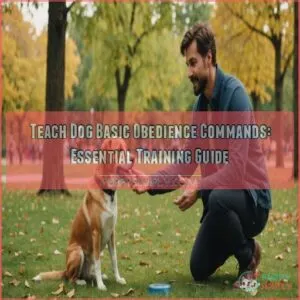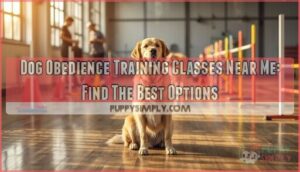This site is supported by our readers. We may earn a commission, at no cost to you, if you purchase through links.
Your dog bolts across the park, ignoring your desperate calls to come back. Or maybe she jumps on every guest who walks through your door, no matter how many times you’ve asked her to sit. These moments don’t just test your patience—they can put your dog in danger or strain your relationships with neighbors and visitors.
The three foundational commands—sit, stay, and come—aren’t just about obedience. They’re safety tools that give you reliable communication with your dog when it matters most.
With the right approach, clear signals, and a pocket full of irresistible treats, you can transform your dog’s responsiveness in just a few focused training sessions.
Table Of Contents
- Key Takeaways
- Preparing for Successful Dog Training
- Teaching Your Dog to Sit
- Training The Stay Command Step-by-Step
- Mastering The Come Command
- Combining Sit, Stay, and Come for Reliability
- Frequently Asked Questions (FAQs)
- How to train your dog to sit, stay, and come?
- How long does it take to train a dog to sit and stay?
- Why won’t my dog sit and stay?
- How to train your dog to come?
- What are the best treats to use for training a dog?
- How do I know if my dog is ready to move on to more advanced commands?
- Can older dogs learn these commands effectively?
- How do you train deaf or blind dogs?
- What if my dog ignores me outdoors?
- Should I use clicker training for these commands?
- Conclusion
Key Takeaways
- Teaching sit, stay, and come with clear cues and consistent rewards builds reliable communication and keeps your dog safe in everyday situations.
- Short, focused training sessions in distraction-free environments help your dog learn commands faster and with less stress.
- High-value, protein-rich treats given immediately after correct responses motivate your dog and reinforce positive behaviors.
- Gradually increasing difficulty and practicing commands in different locations ensures your dog listens and responds no matter where you are.
Preparing for Successful Dog Training
Before you teach your dog anything, you need to set yourself up for success. The right preparation makes training easier, faster, and more enjoyable for both of you.
Let’s look at the key elements that create a solid training foundation.
Choosing The Best Training Treats
The right dog treats can make or break your training sessions. You want rewards that keep your dog engaged without derailing progress. When choosing treats for positive reinforcement, focus on these four essentials:
- Protein content between 20–30% aids training motivation without excess calories
- Small, soft texture allows quick consumption between commands
- Calorie control keeps each treat under 5–10% of daily intake
- Minimal treat ingredients reduce digestive issues
Strategic reward timing beats continuous treating every time. Effective training also requires clear communication and writing clear science.
Setting Up a Distraction-Free Environment
Once you’ve got your treats sorted, location matters just as much. Choose quiet spaces with minimal distractions—somewhere calm, away from TVs, radios, or open doors. A confined area with consistent boundaries helps your dog zero in on you rather than everything else. Neutral backgrounds reduce visual noise, and scheduled sessions during quieter times keep obedience training predictable. Effective training also requires considering research methodology to understand dog behavior.
| Training Element | Best Practice |
|---|---|
| Environment | Low foot traffic areas |
| Noise Level | Silence TVs and radios |
| Space Setup | Clearly defined boundaries |
| Timing | Practice during calm periods |
Establishing Clear Training Cues and Signals
Your dog can’t read your mind, so clear cues and signals make all the difference. Use distinct, single-word commands like “sit” or “stay” paired with consistent hand signals—raising a fist works great for sit. Here’s how to nail cue consistency:
- Say the same word every single time
- Match your hand signal to your verbal cue
- Introduce cues only when your dog’s ready to respond
Practice in quiet spaces first, then add distractions gradually to strengthen response strength and reward timing.
Timing and Consistency in Training Sessions
Once you’ve nailed your cues, session scheduling matters just as much. Keep training sessions short—5 to 10 minutes daily—so your dog stays focused and enthusiastic.
Consistent rewards paired with daily routines build rock-solid obedience training for dogs.
Track feedback loops to catch what’s working, then adjust your training pacing. This deliberate approach transforms positive reinforcement training into lasting canine behavior training that sticks.
Teaching Your Dog to Sit
The sit command is your foundation for all dog training—it’s simple, natural, and gives you control in everyday situations. Teaching it the right way means using a lure to guide your dog’s body, pairing it with a clear signal, and gradually reducing your reliance on treats.
Here’s how to build a rock-solid sit from start to finish.
Luring and Rewarding The Sit Position
Your first step in teaching the sit command is guiding your dog with a tasty treat—this is where positive reinforcement training really shines. Hold the lure just above your dog’s nose and slowly move it back over their head, encouraging that natural sit position without any pulling or pushing.
Here’s how to nail reward timing and lure techniques:
- Keep the treat small and irresistible to maintain focus without filling up your dog too quickly.
- Reward the instant those hips hit the ground, pairing the treat with enthusiastic praise to create a strong behavior-reward link.
- Use consistent hand motion each time you lure, moving from nose level backward over the head in a smooth arc.
That’s the foundation of dog training techniques that work.
Adding Verbal and Hand Signals
Once your dog reliably sits with a lure, you’re ready to layer in verbal cues and hand signals. This dual approach boosts cue discrimination and speeds up learning. Start by saying “sit” clearly, then raise your fist as a hand signal within 1–2 seconds. Reward immediately when your dog responds.
Pairing obedience commands with consistent gestures strengthens recall, especially in noisy environments where verbal cue clarity matters most.
Fading Treats and Using Praise
Gradually, you’ll shift from constant treats to intermittent reward schedules, keeping your dog engaged without food dependence. Here’s how to fade treat reduction while building strong positive reinforcement:
- Start by rewarding every other correct sit, maintaining enthusiastic praise techniques each time
- Pair verbal approval with consistent body language to reinforce your training techniques
- Use high-value treats initially in clicker training, then substitute with praise alone
- Schedule brief sessions to balance consistency with fading expectations
- Monitor progress to verify praise sustains motivation
Troubleshooting Common Sit Issues
When your dog won’t sit on cue or shows inconsistent behavior around distractions, you’re facing classic sit refusal tied to cue dependence.
Address distraction management by returning to quieter spaces, then rebuild the sit command using leash training and proven dog behavior modification approaches.
Teach a dog to sit again using shorter sessions, adjusting your training techniques until reliable responses emerge consistently.
Training The Stay Command Step-by-Step
Once your dog has mastered the sit command, teaching “stay” gives you real control over their movements in everyday situations.
This command takes time to build, and you’ll need to work on three key areas: duration, distance, and distractions.
Here’s how to train a reliable stay, step by step.
Building Duration and Distance Gradually
Think of stay duration and distance training like building blocks—you can’t skip steps and expect a solid foundation. Start with stays of 2–5 seconds at 1–3 meters, then extend gradually. Increase distance in 1–2 meter increments only after three consecutive successes.
Reward systems matter: use high-value treats immediately after each win. Consistency in your training cues ensures gradual progression that sticks.
Adding Distractions and Increasing Difficulty
Your dog won’t stay reliable without real-world challenges. Start with mild distractions like clapping hands or shifting your weight, then introduce toys, sounds, or another calm dog at a safe distance. Aim for 70–85% success before ramping up difficulty.
Practice in at least three different environments—living room, backyard, park—to build true focus and strengthen training cues through gradual exposure and positive reinforcement.
Using Consistent Release Cues
A clear release word like “okay” or “free” tells your dog when the Stay Command is over. Without Cue Consistency, your dog won’t know when to move—or worse, will guess and break position early.
Pair your release word with Reward Synchronization so treats arrive right after the cue, not during the stay. This Verbal Signals timing builds trust and strengthens canine training reliability across all dog behavior and psychology contexts.
Practicing Stays in Different Locations
Once your dog understands the release word, practice stays in various Location Variations—quiet rooms, your backyard, then busier urban environments.
Indoor stays with minimal outdoor distractions build confidence before you tackle parking lots or sidewalks. Start Distance Training at three to five feet for five seconds, then gradually extend both.
Rotating locations weekly prevents your dog from learning place-specific cues while strengthening these essential canine training techniques.
Mastering The Come Command
Teaching your dog to come when called is one of the most important skills you’ll ever train, and it could even save their life one day.
Training your dog to come when called is a life-saving skill every owner should teach
A strong recall means your dog will return to you no matter what’s happening around them, whether that’s a squirrel darting across the yard or another dog approaching at the park.
Here’s how to build a reliable come command from the ground up.
Introducing Recall With Short Distances
At the start of recall techniques, you’ll want to keep things simple by working at short distance in a quiet room. Choose one clear cue—something like “here”—and pair it with an enthusiastic tone.
This early distance training helps your dog understand the basics without confusion. As a dog owner, consistent recall cues during these short sessions will build a strong foundation for reliable performance.
Using Rewards to Motivate Returning
Once your dog starts responding at close range, you’ll need the right rewards to keep recall motivation strong. High value treats—like warm, savory bites—work best when delivered within two seconds of their return.
Variable rewards keep things exciting for your pup, while reward consistency builds trust. As a dog owner using positive reinforcement training, you’re teaching canine communication that pays off every time.
Adding Verbal Cues and Hand Gestures
When you pair your words with clear movements, your dog learns twice as fast. Verbal Cue Timing and Hand Signal Consistency work together to strengthen Cue Association, making Teaching Dog Commands more reliable through Visual Reinforcement and Synchronized Commands.
- Say “come” in a calm tone while sweeping your arm toward your chest
- Keep your hand at shoulder height for visibility
- Reward immediately when your dog obeys either cue
- Practice both cues simultaneously in quiet spaces first
- Use the same gesture every time to teach a dog to sit and master the Stay Command
Practicing Recall in Real-World Scenarios
Beyond your living room, Real World Applications test everything your dog has learned. Start in quiet yards, then move to parks where environmental factors like sounds and smells compete for attention. Use distraction management by keeping sessions short and rewards high-value. Always follow safety protocols—attach a long line during early practice to prevent escapes while building reliable dog recall through consistent dog-owner guidance.
| Location Type | Distraction Level | Recommended Duration |
|---|---|---|
| Fenced backyard | Low | 5–10 minutes |
| Neighborhood park | Medium | 3–5 minutes |
| Busy hiking trail | High | 2–3 minutes |
Combining Sit, Stay, and Come for Reliability
Once your dog knows sit, stay, and come individually, it’s time to link them into a reliable sequence that works in real-world situations. This section walks you through putting these commands together, reinforcing progress with positive methods, and adjusting your approach when things don’t go as planned.
You’ll also learn how to generalize these behaviors so your dog listens whether you’re at home, in the park, or visiting friends.
Sequencing The Commands Together
Once your dog reliably obeys each individual cue, command sequencing transforms those skills into fluid dog obedience. Start with sit, follow with stay, then call your dog with come—always in this fixed order.
Cue consistency matters: use the same words and hand signals every session. Practice in short training sessions, gradually adding distance and distractions to build sequence generalization.
Error prevention means resetting immediately when your dog skips a step.
Reinforcing Behaviors With Positive Reinforcement
Consistent positive reinforcement training transforms isolated cues into reliable behavior chains. Apply operant conditioning by delivering treats and rewards within two seconds of each correct response, strengthening your dog’s understanding through reinforcement theory.
Here are five dog training tips for effective reward schedules:
- Use high-value treats during early practice
- Pair clicker training with verbal praise
- Vary rewards to maintain motivation
- Deliver immediate reinforcement after each cue
- Gradually shift to intermittent schedules
Troubleshooting and Adjusting Training Plans
When progress stalls, shift your approach instead of pushing harder. Track each session’s success rate to pinpoint training obstacles—whether it’s session timing, adjusting rewards, or distractions throwing your dog off track.
If your dog loses motivation, revisit your reward structure and practice schedule. These plan revisions aren’t setbacks; they’re essential dog training tips that help you fine-tune positive reinforcement training for lasting results.
Generalizing Obedience to Everyday Situations
Once your dog nails sit-stay-come at home, it’s time to take household obedience on the road.
Real world applications demand distraction management and socialization techniques across different environmental factors. Practice commands at the park, near busy sidewalks, and during daily walks—everyday situations where pet obedience matters most.
This pet training advice ensures dog owner guidance translates into reliable behavior anywhere you go.
Frequently Asked Questions (FAQs)
How to train your dog to sit, stay, and come?
Training your canine companion isn’t rocket science—start with sit using treats as lures, build stay through gradual duration and distance, then master come with high-value rewards and consistent verbal cues in low-distraction spaces.
How long does it take to train a dog to sit and stay?
You’ll generally see reliable results within two to six weeks of daily practice, though dog breed factors, age influence, and your reward systems shape how quickly your pup masters these commands.
Why won’t my dog sit and stay?
Your dog may struggle with sit and stay due to inadequate impulse control, unclear expectations, or medical issues like hip pain. Environmental stressors and inconsistent reinforcement also disrupt obedience responses markedly.
How to train your dog to come?
Start with a clear, enthusiastic recall cue in a low-distraction space. Reward your dog immediately when they return to you.
Gradually increase distance and practice in various locations to strengthen their response.
What are the best treats to use for training a dog?
Ironically, the best training bites aren’t always store-bought—soft, high-value treats like small pieces of chicken work wonders for reward timing and calorie control when you teach a dog to sit effectively.
How do I know if my dog is ready to move on to more advanced commands?
Your assessment criteria should focus on consistent performance: if your dog nails sit, stay, and come nine out of ten times in mild distractions, that readiness evaluation signals you’re prepared for higher-level training.
Can older dogs learn these commands effectively?
You can absolutely teach an old dog new tricks—research proves senior dog training works with patience.
Age-related challenges like cognitive decline and health considerations require adjusted sessions, but elderly dog motivation remains strong with proper rewards.
How do you train deaf or blind dogs?
Visual cues, tactile training, and sensory adaptation help deaf or blind dogs succeed. Use hand signals, scent markers, or gentle touch paired with immediate rewards.
Work with a certified trainer experienced in canine rehabilitation for customized guidance.
What if my dog ignores me outdoors?
Outdoor distractions overwhelm your dog’s focus. Start training in quieter spaces, use high-value treats, and keep sessions short.
Gradually increase environmental factors while maintaining training consistency to strengthen recall strategies and reduce canine anxiety outdoors.
Should I use clicker training for these commands?
Clicker training delivers distinct, precise timing that clarifies exactly what behavior you’re rewarding. This dog training technique strengthens canine training foundations for sit, stay, and come by marking correct responses instantly—boosting dog motivation through clear reward systems.
Conclusion
Teaching a dog to sit, stay, and come is like building a bridge between two languages—you’re creating shared meaning one repetition at a time. Each command you practice strengthens your dog’s ability to hear you clearly, even when distractions compete for her attention.
With patience, consistency, and the right rewards, you’ll transform those three foundational commands into lifelong safety tools. Start today, stay committed to the process, and watch your dog’s responsiveness grow with every session.
- https://akc.jotform.com/252115238925860?source=16
- https://onlinepubs.trb.org/onlinepubs/nchrp/cd-22/manual/v1appendixb.pdf
- https://academichelpexpress.blog/2024/08/please-use-the-bulleted-points-and-the-rubric-below-to-guide-your-work-your-pa/
- https://www.linkedin.com/posts/bohdanlukianets_tasks-study-research-activity-7373377539521667072-UTEi
- https://www.writingclearscience.com.au/category/writing-guides/writing-research-papers/page/2/

